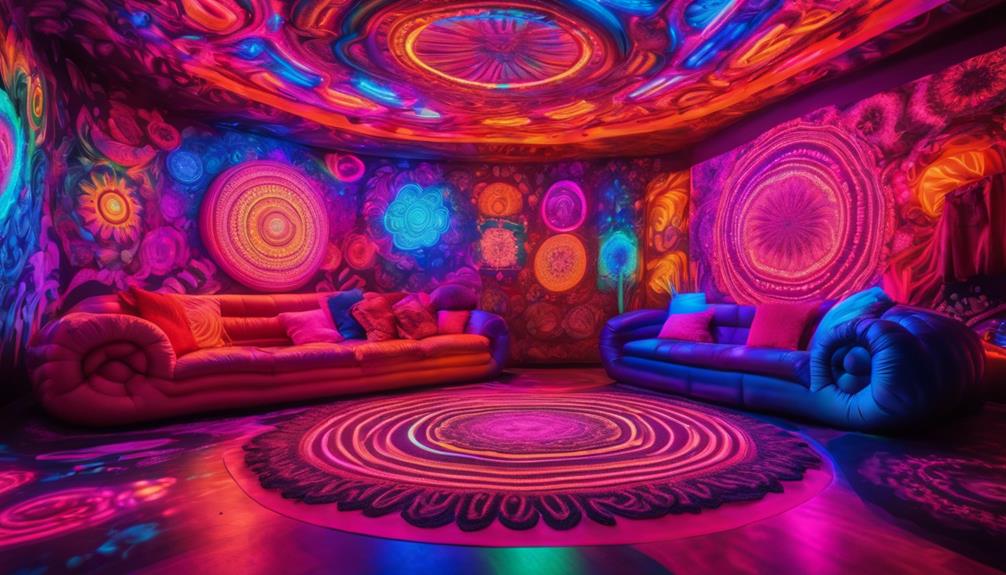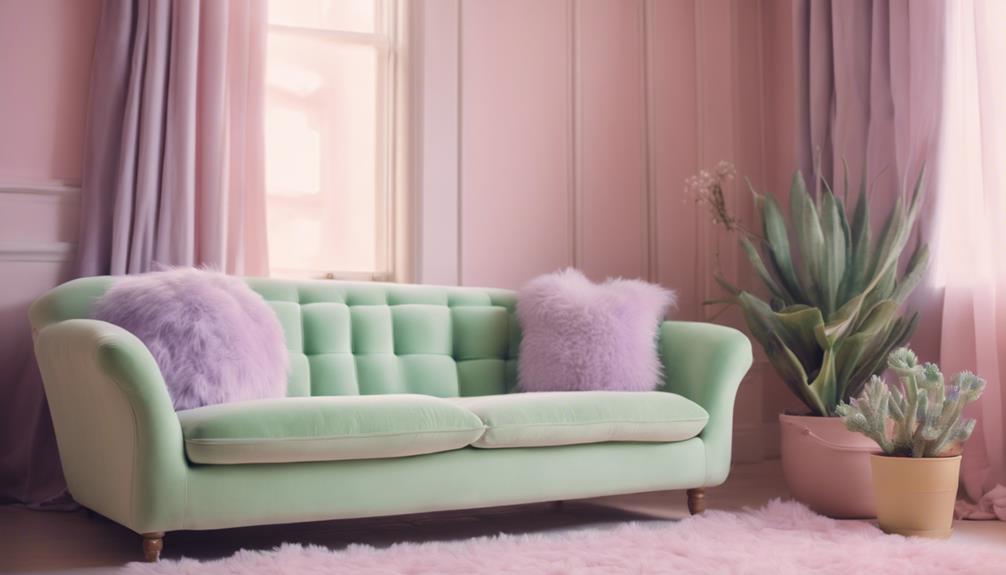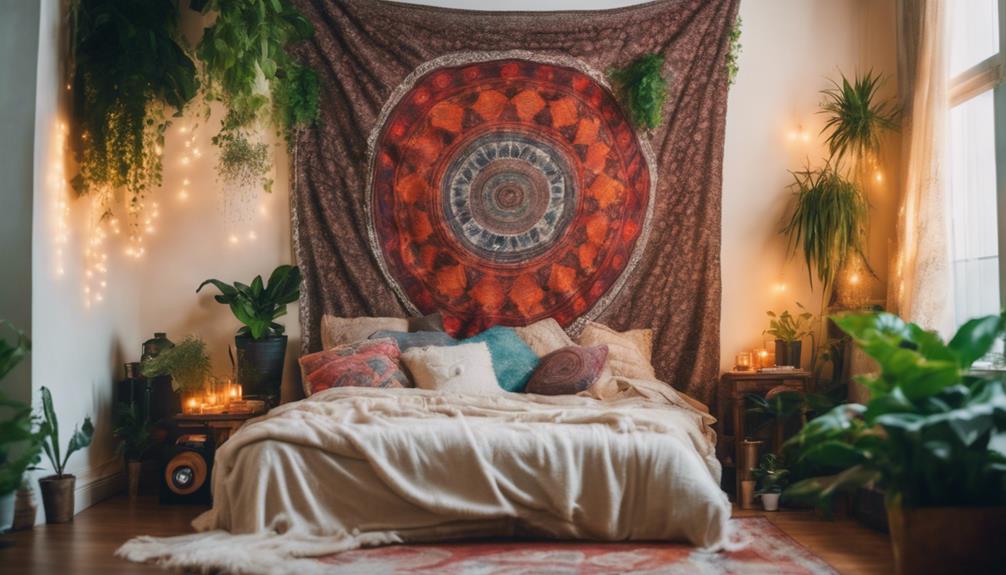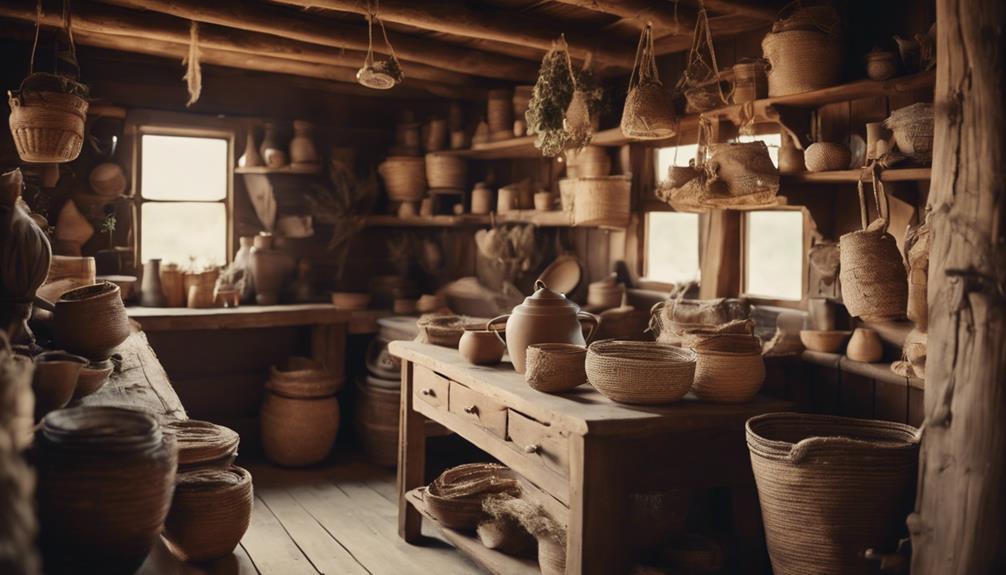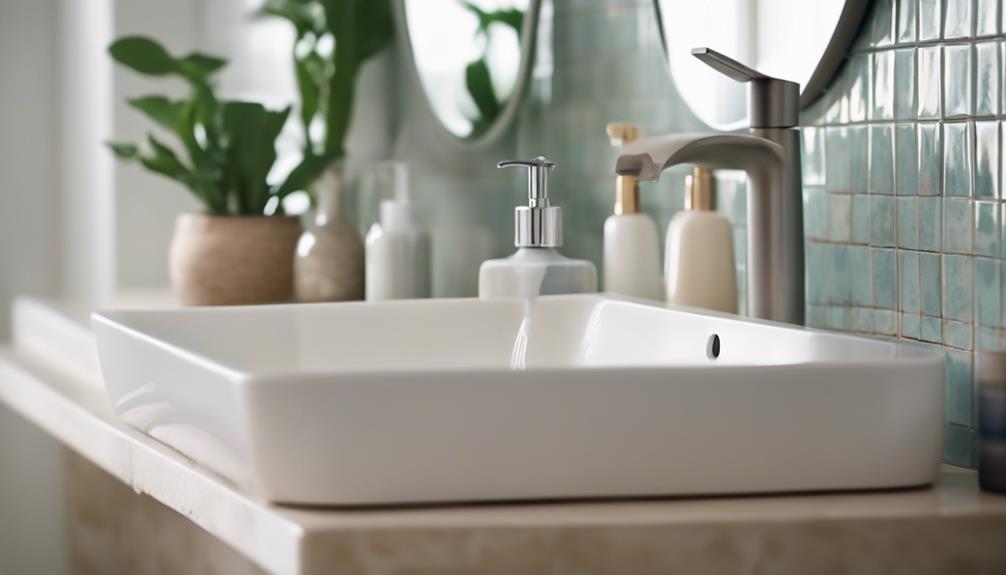To create a trippy room decor that wows, embrace bold, vibrant colors. Use contrasting palettes like purple and neon green for impact. Incorporate unique textures with psychedelic tapestries and cozy rugs to enhance the vibe. Add dynamic lighting, like color-changing LED strips and funky projectors, to transform the atmosphere. Quirky furniture, such as neon lava lamps and fun bean bag chairs, can become focal points in your space. With these elements combined, you'll create a truly immersive experience. Want to discover more exciting ideas to amp up your psychedelic aesthetic?
Key Elements
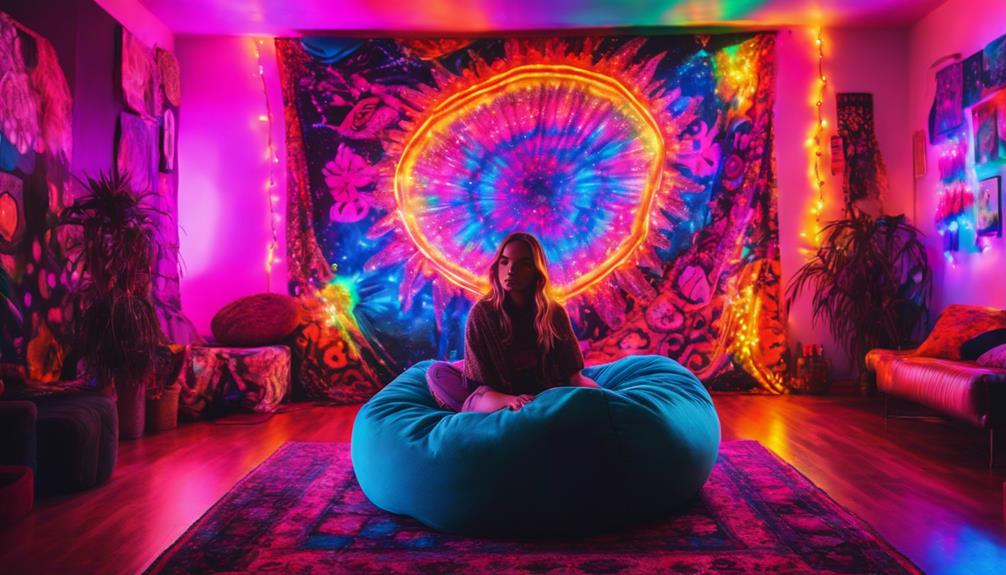
When you create trippy room decor, the color scheme is your first focus—think bold, vibrant hues that energize the space.
Next, consider the materials and textures you choose; these elements can add depth and intrigue to your design.
Color Scheme
A vivid color palette is essential in creating a trippy room aesthetic, with contrasting combinations like red and green or orange and blue delivering a dynamic visual impact.
You'll want to focus on incorporating neon hues such as purple, neon green, and angry pink, as these colors evoke a sense of altered reality and heightened consciousness.
To enhance your color scheme, consider using black lights; they can make tapestries and art glow, amplifying the vibrancy of your decor.
Pair this with LED light strips or fairy lights that you can program to change colors, adding movement and depth to your space.
Don't shy away from an oversaturated approach—bold and bright tones should dominate your design, creating an enchanting and visually stimulating environment.
Experiment with different combinations until you find the perfect mix that resonates with your vision of a trippy aesthetic.
Ultimately, remember that your color scheme isn't just about aesthetics; it can shape your mood and experience in the room, so choose colors that inspire and invigorate you!
Materials
To create a truly immersive trippy room, you'll want to select materials that not only pop with color but also incorporate unique textures and patterns that enhance the overall vibe.
Start by adding vibrant tapestries and posters featuring trippy patterns, like mushrooms and kaleidoscopic shapes, to establish a psychedelic focal point. This will draw the eye and set the tone for your space.
Next, utilize materials like faux vines and abstract vases to introduce organic elements that complement your colorful decor. Bedding and rugs with psychedelic designs, including mandalas and tie-dye patterns, will deepen the immersive experience of your trippy room decor.
Don't forget to incorporate UV-reactive decorations that glow under black light. These will create dynamic visual effects, transforming the ambiance as the light shifts.
Finally, choose furniture with bold, whimsical designs, such as mosaic tables or quirky vintage pieces, to reinforce the eclectic and vibrant nature of your trippy room decor.
Textures
Incorporating a variety of textures in your trippy room decor elevates the psychedelic experience, inviting both visual intrigue and tactile interaction. Consider using soft faux fur, silky fabrics, and intricate tapestries to enhance the room's ambiance. These textures create a warm and inviting atmosphere that draws people in.
Adding 3D wall hangings or textured wall art brings depth and encourages touch, making your space feel alive. Don't forget about rugs with psychedelic patterns; they often combine plush and shag textures, providing a cozy yet vibrant foundation for your decor.
Layering different textures is key. Mix smooth surfaces with rough or patterned elements to create visual interest and complexity. For instance, pairing a sleek table with a woven macramé hanging introduces contrast that excites the senses.
Textured accessories like beaded curtains can also contribute to the trippy aesthetic, adding a playful and dynamic element to your room.
Essential Fixtures and Furniture
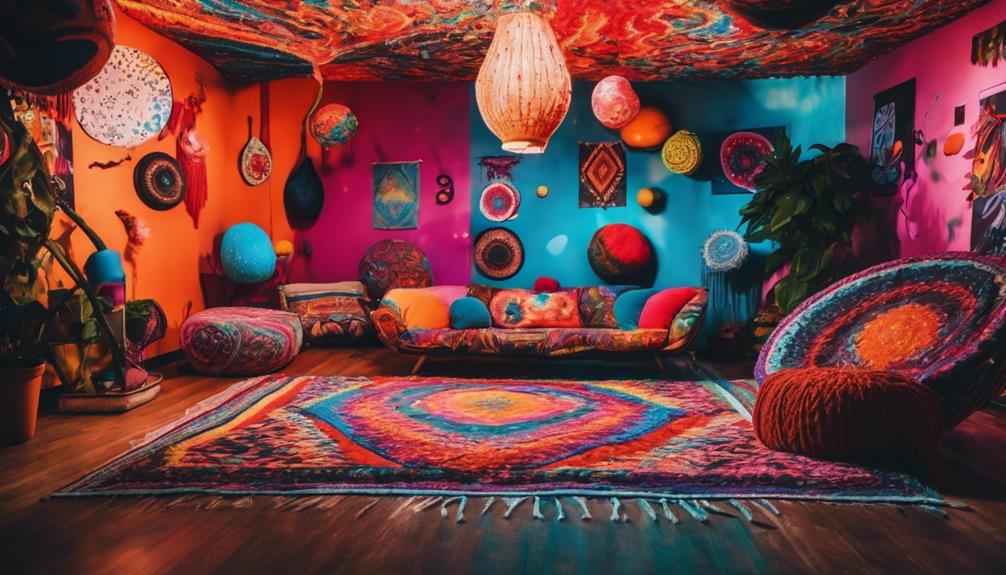
When you're setting up your trippy room, consider essential fixtures and furniture that amplify the vibe.
A neon lava lamp, hanging beaded curtain, and a psychedelic bean bag chair can transform your space into a vibrant oasis.
Each piece plays a vital role in creating a fun and inviting atmosphere that sparks creativity.
Neon Lava Lamp
Neon lava lamps enchant with their vibrant colors and mesmerizing light displays, making them essential fixtures for any trippy room decor. These iconic lamps combine colorful wax and a liquid base, creating unique, flowing patterns when heated. This enchanting motion not only serves as a focal point in your space but also enhances the psychedelic ambiance that defines your decor.
You can find neon lava lamps in various sizes and styles, from small desktop versions perfect for your work area to larger floor models that can anchor a room. This versatility gives you the freedom to choose the right lamp for your space. The soft glow from these lamps contributes to a calming atmosphere, ideal for relaxation.
When you pair neon lava lamps with other lighting elements, like LED strips or string lights, you can create a dynamic, immersive environment that invites creativity and artistic expression. They add visual interest and enhance the overall vibe of your room, making it a perfect sanctuary for inspiration and relaxation.
Embrace the magic of neon lava lamps to elevate your trippy room decor to the next level!
Hanging Beaded Curtain
Hanging beaded curtains add a striking visual element to your trippy room, enhancing its vibrant atmosphere with layered textures and dynamic reflections. These curtains are perfect for creating a psychedelic aesthetic, transforming your space into an immersive experience. Available in various materials like acrylic, wood, and glass beads, you can customize them in different lengths and color combinations to match your unique style.
Beyond their visual appeal, hanging beaded curtains function as space dividers, allowing you to create distinct areas within your room while keeping an open feel. The flickering light that passes through the beads generates mesmerizing reflections and shadows, amplifying the psychedelic art theme you're aiming for.
Installation is a breeze, making them a versatile choice for renters or anyone looking to switch up their decor frequently. You can easily hang or remove them without hassle, giving you the freedom to experiment with different looks.
Psychedelic Bean Bag Chair
A psychedelic bean bag chair instantly transforms your space with its vibrant colors and funky patterns, making it a must-have for any trippy room. These versatile seating options not only provide comfort but also enhance the overall aesthetic with their eye-catching designs. You can find them in various sizes and shapes, allowing you to play around with creative arrangements that fit your decor style.
Most psychedelic bean bag chairs are made from durable, easy-to-clean materials, ensuring they withstand regular use without fading. The designs often feature popular motifs like swirls, peace signs, or abstract shapes that align perfectly with the psychedelic vibe, promoting relaxation and fun.
Lighting Ideas
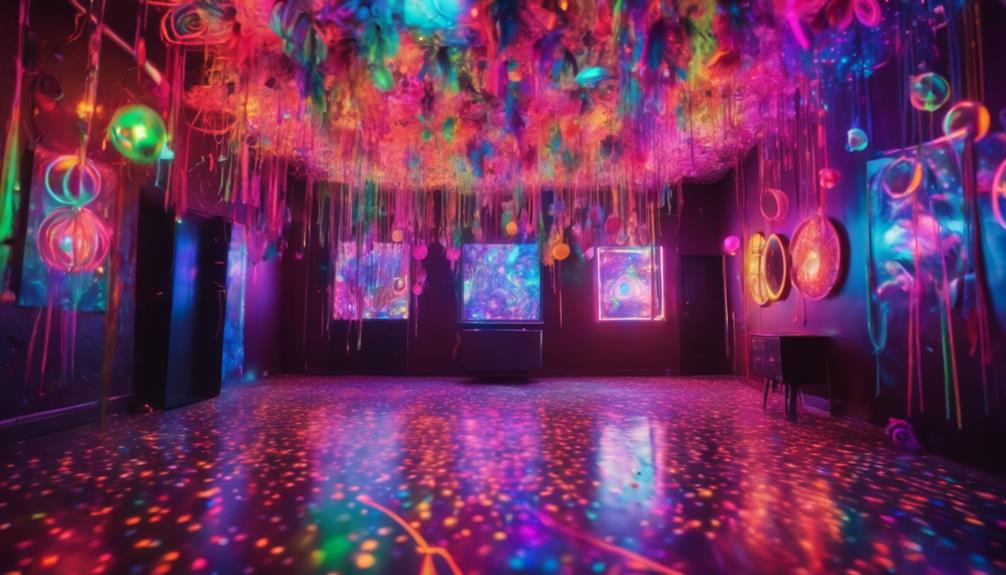
When it comes to lighting your trippy space, you've got some exciting options to explore.
Color-changing LED strip lights and psychedelic projectors can transform your room with vibrant colors and mesmerizing patterns.
Don't forget to take into account fiber optic ceiling lights and a custom neon sign to add that personal touch to your ambiance!
Color-Changing LED Strip Lights
Color-changing LED strip lights transform your space with over 16 million vibrant color combinations, perfectly matching any mood or occasion. Imagine setting the scene for a chill evening or an energetic party with just a few taps on your smartphone. These lights typically come with app control, letting you adjust brightness, speed, and color shifts effortlessly.
With a lifespan exceeding 50,000 hours, color-changing LED strip lights guarantee your decor remains vibrant for years, requiring minimal maintenance. Want to take it up a notch? Use the advanced sound-reactive features to sync the lights with your favorite music, creating an immersive psychedelic experience that will wow your guests.
Placement is key; strategically placing these lights can highlight unique patterns in your room, enhancing the overall atmosphere. Whether you run them along walls, ceilings, or furniture, they create dynamic effects that draw the eye.
Incorporate color-changing LED strip lights into your trippy room decor, and you'll find it easy to transform your space whenever inspiration strikes. With endless customization options, you'll always have the perfect vibe for any occasion.
Fiber Optic Ceiling Lights
Fiber optic ceiling lights instantly elevate your space, creating an enchanting starry effect that enhances the trippy ambiance. With twinkling light patterns mimicking a night sky, these lights transform your room into a mesmerizing retreat. You'll love how energy-efficient these systems are, and the ability to customize them in various colors allows you to tailor the experience to match your psychedelic aesthetic.
Installation is straightforward; you just need a small hole for the fibers, resulting in a clean and sleek look without bulky fixtures. Plus, many fiber optic ceiling lights come with remote control options, letting you easily change colors, brightness, and lighting patterns to suit your mood or occasion. Imagine hosting a gathering where the ceiling sparkles with vibrant colors, creating an immersive atmosphere that wows your guests.
Versatile in use, fiber optic lights fit perfectly in various settings, from home theaters to relaxation spaces. They're ideal for adding a unique and dynamic touch to any room.
Embrace the magic of fiber optic ceiling lights and watch as they transform your space into a trippy haven that everyone will adore!
Psychedelic Projector Light Show
Psychedelic projector lights instantly transform your room into a mesmerizing wonderland, casting dynamic patterns and colors that dance across your walls and ceiling. These lights create stunning visual effects, enhancing the overall trippy ambiance of your space.
With various options available, you can choose from galaxy projectors that showcase starry skies to kaleidoscope projectors that generate swirling, colorful designs.
One of the coolest features of many psychedelic projector lights is their sound-reactive capability. This means the light patterns sync with your music, making them perfect for creating a relaxed vibe or energizing a party atmosphere. By using a variety of color combinations and patterns, you can turn any space into an immersive environment that stimulates creativity and artistic expression.
To elevate your room's aesthetic, consider combining psychedelic projector lights with other lighting elements like LED strips and lava lamps. This combination won't only enhance the visual experience but also foster a unique atmosphere for personal relaxation or social gatherings.
Neon Sign With Custom Message
A custom neon sign can instantly elevate your trippy room decor, allowing you to showcase your personality with vibrant colors and unique messages.
These eye-catching neon signs are perfect for adding a personal touch, and they come in a variety of hues, including the striking neon greens, purples, and pinks that embody the psychedelic aesthetic.
You can choose a custom message that resonates with you or captures your mood, making it a fantastic conversation starter. Plus, many of these signs utilize energy-efficient LED technology, providing over 50,000 hours of illumination, so you can enjoy your neon art for years to come.
When selecting your neon sign, think about the size and font that will best fit your space. A well-placed sign not only serves as a focal point but also helps create a whimsical and inviting atmosphere, perfect for relaxation or social gatherings.
Decorative Elements
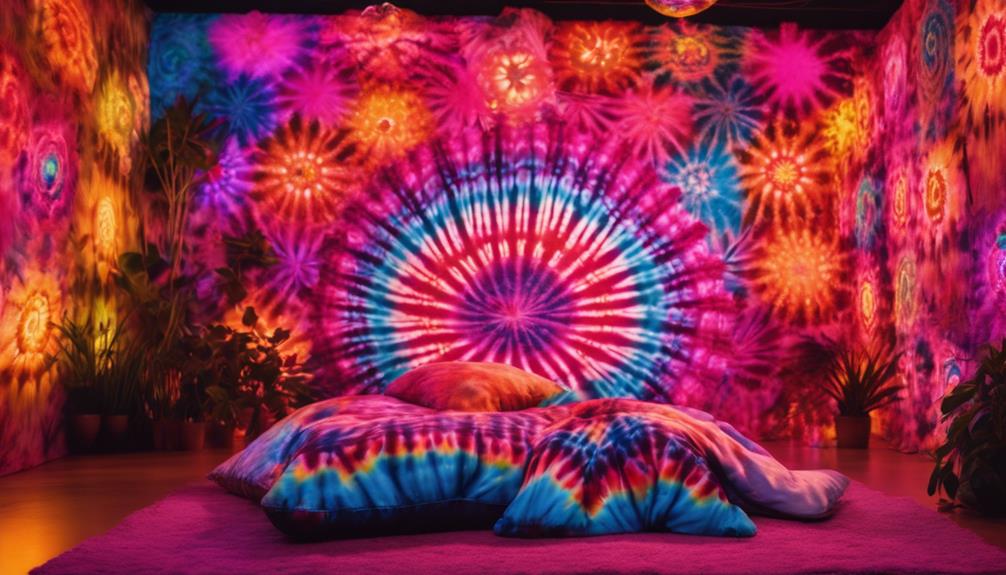
When you think about decorative elements for your trippy room, consider vibrant tapestry wall hangings that instantly grab attention.
Holographic wall decals can add a futuristic twist, while a mosaic glass table centerpiece brings a touch of artistry.
Each piece plays an essential role in creating that immersive, psychedelic vibe you're aiming for.
Psychedelic Tapestry Wall Hanging
Transform your space with a vibrant tapestry wall hanging that features surreal motifs and kaleidoscopic patterns, creating an immersive trippy atmosphere. A psychedelic tapestry wall hanging can instantly become the focal point of your room, drawing everyone's attention and setting the tone for your decor. With vivid colors like neon green, purple, and angry pink, these tapestries enhance your room's visual appeal and evoke a sense of altered reality.
Made from lightweight, durable fabrics, these tapestries are easy to hang and switch out, allowing you to adapt your space according to your mood or personal style. You can use your psychedelic tapestry wall hanging as a standalone piece or incorporate it into a wall collage, adding depth and personality to your decor.
These decorative elements not only brighten up your space but also encourage creative expression. Whether you're channeling a retro vibe or a modern twist, a psychedelic tapestry wall hanging can perfectly capture the essence of your trippy aesthetic.
Embrace the opportunity to transform your environment into an enchanting haven that wows everyone who steps inside.
Holographic Wall Decals
Holographic wall decals add an enchanting touch to your trippy room decor with their dynamic designs and light-reflective materials. These decals feature surreal motifs like mushrooms, aliens, and kaleidoscopic shapes that perfectly align with the psychedelic aesthetic you're aiming for. When the light hits these decals, the holographic textures create mesmerizing visual effects that change with your viewpoint, enhancing the overall atmosphere of your space.
Available in various sizes, these decals are incredibly versatile. You can easily apply and remove them, making them ideal for renters or anyone who loves to frequently refresh their decor. Plus, many of these decals are UV-reactive, glowing beautifully under black lights, which intensifies the immersive experience in dimly lit settings.
Incorporating holographic wall decals into your room not only adds vibrant visuals but also creates a sense of depth and movement on your walls. This effect makes your space feel more expansive and engaging, transforming it into an enchanting haven.
Whether you're lounging or entertaining, these decals will surely wow everyone who steps inside!
Mosaic Glass Table Centerpiece
A mosaic glass table centerpiece instantly becomes a vibrant focal point in your trippy room, showcasing intricate patterns that beautifully reflect light and color. These stunning pieces often feature an array of neon hues like purple, green, and pink, perfectly aligning with your psychedelic aesthetic.
You can choose from a variety of sizes and complexities for your mosaic glass table centerpiece, ensuring it fits your table dimensions and personal style. Whether you prefer a simple design or a more elaborate arrangement, these centerpieces add both beauty and functionality to your space. They protect your table surface while enhancing the overall ambiance of the room.
To create a cohesive look, pair your mosaic glass table centerpiece with other trippy decor elements, such as patterned rugs and vibrant wall art. The interplay of colors and patterns across your space will leave a lasting impression on anyone who visits.
Flooring
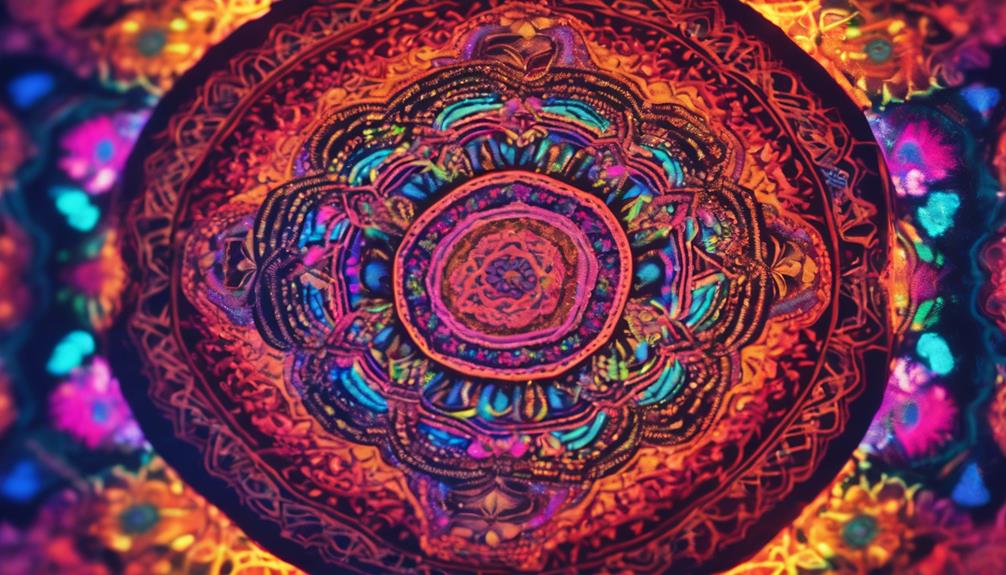
When it comes to trippy flooring, you've got some vibrant options to choose from.
Colorful patterned area rugs can add a splash of psychedelic flair, while vinyl floor tiles offer a unique twist with their eye-catching designs.
Don't forget glow-in-the-dark carpet tiles for that extra element of surprise when the lights go down!
Colorful Patterned Area Rug
Colorful patterned area rugs can instantly transform your space, drawing attention with their vibrant designs and enhancing the trippy vibe of your room. These rugs often showcase bold colors like neon green, purple, and angry pink, making them a central focal point in any psychedelic-themed setting.
Vibrant patterns such as tie-dye or geometric shapes add layers of visual interest, creating an immersive experience that captivates the senses. When you choose a colorful patterned area rug, consider options that are UV-reactive for an added wow factor, especially under black light. This can greatly amplify the dynamic atmosphere, making your room feel alive.
Besides their striking aesthetics, these rugs also provide comfort and warmth, defining spaces within your room and inviting you to relax. Don't forget to select materials that are easy to clean and maintain. This will help keep your colorful patterned area rug looking vibrant and inviting over time, ensuring it remains a key element of your trippy decor.
Psychedelic Vinyl Floor Tiles
Why not consider psychedelic vinyl floor tiles to create a vibrant and immersive foundation for your trippy room decor?
These tiles feature swirling patterns and neon colors that resonate with the essence of psychedelic drugs, instantly elevating your space. With designs ranging from kaleidoscopic motifs to abstract art, you can easily find a style that matches your unique taste and enhances your overall theme.
One of the best aspects of vinyl floor tiles is their ease of installation and maintenance. You won't have to deal with the hassle of traditional flooring, allowing you to focus on your creative vision. Plus, these tiles are durable and resistant to wear, ensuring that the colorful patterns remain intact even in high-traffic areas, making them perfect for lively gatherings.
Additionally, vinyl flooring helps reduce noise and provides comfort underfoot, creating a cozy atmosphere that invites relaxation and creativity.
Glow-In-The-Dark Carpet Tiles
Transform your space with glow-in-the-dark carpet tiles that absorb light during the day and radiate enchanting hues at night, enhancing your trippy room decor.
These tiles create a mesmerizing effect, making them perfect for anyone looking to elevate their psychedelic aesthetic. Available in vibrant colors like neon green, purple, and angry pink, they add that essential pop to your flooring.
Not only are glow-in-the-dark carpet tiles visually striking, but they also provide comfort and cushioning underfoot. This makes them ideal for relaxation spaces where you can unwind and let your imagination run wild.
Installation is a breeze; you can customize the layout to fit various room shapes and sizes, allowing for a truly unique design.
With proper care, these tiles can maintain their glow for years, ensuring a long-lasting addition to your decor.
Whether you're hosting a party or simply enjoying a quiet evening, the enchanting glow of these carpet tiles will wow everyone and immerse you in a trippy experience.
Conclusion
By incorporating these key elements, you can easily transform your space into a psychedelic haven.
Choose vibrant fixtures and furniture that reflect your personality, and don't underestimate the power of lighting to set the mood.
Add decorative elements that spark joy and intrigue, while paying attention to flooring that complements your overall aesthetic.
With a little creativity and bold choices, you'll create a trippy room that wows everyone who steps inside!
Embrace the journey and enjoy the vibe!
